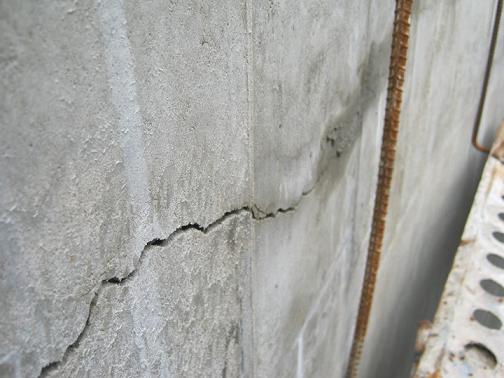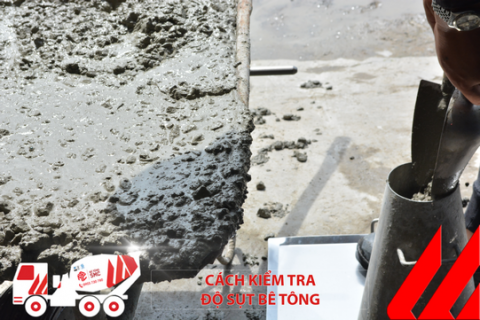Frequently asked Questions
Concrete engineering advice
Business contact
The cause and how to overcome the phenomenon of concrete cracking
Currently, concrete cracking is very common in construction works, especially cracks accompanied by water leaks such as roof floors, water tanks, tunnels in traffic ... reducing the life of the project. . Causes and remedies of concrete cracking phenomena will be presented in this article.Reason
The floor of your concrete crack phenomenon is due to the impact of weather factors, making your floor has small cracks, this cracking is not worrying. The second reason is that the subjective people of the construction works do not calculate the structure of the house properly, do not have suitable steel structure, do not meet the standards of concrete marks ... or due to some integers. The main factors are as follows:
- Concrete with high compressive strength (greater than 300kg / cm2) prone to cracking phenomenon.
- Cracking concrete focuses on floor structure, concrete wall has a large area.
- Use the amount of quick freezing chemicals in excess of the allowed level (the faster the time to dismantle phase reinforcement, the more likely the floor will be cracked)
- Pour concrete at high outdoor temperatures.
- Maintenance of concrete is not good.

Some types of concrete cracks and how to fix them
Lightly cracked and shallow feet
Light cracks, shallow, crow's feet usually only lay in plaster layer, do not penetrate into brick walls ... there are usually reasons: wall painting techniques (the walls are too dry, the mixing tank is uneven, the paste pools). thin - must be at least 1cm long, covered with plenty of sunshine, not curing properly ...). Or painting and painting is not the right technique, construction process is wrong.
For the above reasons, it is necessary to chisel the old lake layer along the cracks, carefully treat it, get enough moisture and re-apply with old cement mortar and fine sand. If blistered, remove the entire wall to re-fill. The lacquer layer must last for at least 7 days to treat rub, plaster, paint.
Deep crack, through the masonry wall
Need to watch carefully: Cracked concrete at the edge adjacent to wall-column due to construction techniques, did not place or put insufficient beard steel anchor to the wall. In this case, use a deep groove cutting machine to clean, moisten and tighten ready-fix quick repair mortars and re-plaster with regular plaster.
Cracked concrete at the edge adjacent to the wall - Da momentum: also due to construction errors did not handle the lake oil and moisture properly, and built in contravention of regulations (slanting, masonry, brick , blank corners must be carefully rubbed the lake). As a result, during the hardening process, the walls and the walls of the masonry and plaster are partly shrinkage, causing a horizontal concrete crack.
Can use crack repair method as above. Or carve out the top row of bricks to rebuild according to regulations.
Concrete crack at the edge adjacent to the wall-surface is often found on floors: also due to technical errors in construction. After casting momentum, floors of floors, before building walls, on the concrete surface will be built to be clean, moist enough; must have a layer of oil paste, carefully. A minimum of 3 rows of nail tiles (solid bricks) should be built in advance. Hardness is gradually shifted from the momentum of concrete floors to solid bricks and tube bricks, which will limit the appearance of cracks. If not properly implemented, there may be cracks. How to fix it with high-grade mortar as mentioned, but the price is quite expensive.
These cracks are mainly due to sagging floor momentum. Therefore, the cross-section of the components (momentum) must be sufficiently hard and reinforced enough that this deflection is not significant. It is these cracks, in the walls of the toilet, in the gable wall is the water-repellent area, causing patchy.
Cracked at the top of the door and any cracks
Cracking concrete at the edge of the door usually appears in the corners on doors, windows. This type of crack occurs because the momentum of the door is not long enough, not enough to anchor the pillow on both ends of the wall and during use, the wall was closed too hard. Want to prevent from the beginning, the flax on the top of the door, the window must be long enough, to reach the minimum of 20cm from the door (if possible, cast flax to cross the column). Saving the length of the cylinder will result in a very difficult repair of these types of cracks.
The most effective way to fix is to completely remove the flax momentum, replace it with a longer, more anchor. Local crack of the cylinder head, grouting only a little increase in hardness, often ineffective, meaning that it will crack again some time later, especially when the door is closed.
Tilted concrete cracks on the wall are the most annoying and most difficult to repair. Usually it can appear on many walls, on many floors. The rule is to appear near the edge of the floor, near the columns and oblique into the middle of the wall plate; or appear in the lower corners of the windowsill, slanting down. The reason is that your house or building has subsided more or less! Want to fix subsidence against many different solutions, both difficult and expensive. The hollowed cracked, closed "gong" (leech nail) to "sew" the crack is only temporary and ineffective; because it does not prevent the cause of the crack and will crack, be it the old place or around it.
In addition, it is not recommended to use concrete with high compressive strength in private buildings, it is recommended to use the type of strength 200kg / cm2. Limiting the use of fast hardening chemicals.
Should pour concrete at night, curing as soon as new concrete hardens.
Construction of the raw part should have heat expansion joints when the floor edge is too long (the long side should not exceed 40m).
Other news
Currently, ready-mix concrete is a top choice for many construction projects—both large and small—thanks to its convenience, consistent quality, and high construction efficiency. With extensive experience supplying commercial concrete for numerous key projects in the Southern region, SMC proudly offers a diverse range of ready-mix concrete products to meet the technical requirements of every type of construction.
A Comprehensive Guide to Concrete Specs – Everything You Need to Know
A Complete Guide to Concrete Specs – a set of technical parameters including concrete grade, slump, compressive strength, aggregate size, and mix ratio. This article helps you understand how to define, apply, and control concrete quality according to TCVN standards and practical construction conditions.
How to check the concrete slump
In construction and civil engineering, concrete slump test (or simple slump test) is the work performed at the construction site or in the laboratory that usually determines and measures the hardness, consistency of samples. Concrete before pouring concrete or casting maintenance, research or experiment samples.




